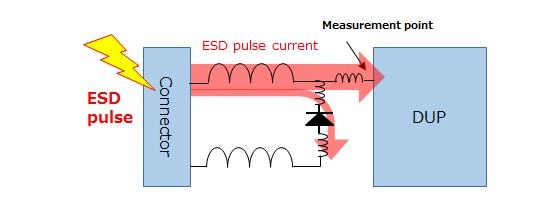What Is An Esd Overvoltage Protection Device:principle, Type And Application
In the design of electronic products, there is an invisible but very "fatal" threat - electrostatic discharge (ESD). Don't underestimate this tiny electric spark. It could instantly render your chip unusable. To solve this problem, engineers have developed a special type of "protective shield" : ESD Overvoltage Protection Devices. In this article, we will take you through a comprehensive understanding of the working principles, common types, selection techniques of these protection devices, as well as their significant roles in practical applications.
1. What Exactly Is an ESD Protection Device?

ESD stands for Electrostatic Discharge Protection Diode, also known as TVS Diode. It is a type of Zener Diode and is used to protect electronic circuits from overvoltage pulses, switching surges, and lightning surges.Put simply, an ESD protection device is a component that “absorbs” static shocks in a circuit. For example, if you’ve built up static on your body and touch a phone’s charging port, that discharge could travel into the chip. An ESD protector acts like a valve—it immediately shunts the excess voltage to ground so the circuit stays safe. You’ll typically find these devices placed at all input and output ports on a PCB—they’re essential for keeping your electronics running reliably over time.
2. ESD的工作原理

When an ESD event occurs, voltage can spike into the thousands of volts in just a few nanoseconds. ESD protectors use a “clamping” mechanism to instantly limit that spike to a safe level and divert the extra current away from sensitive circuitry.
Key characteristics include:
- Ultra-fast response (usually under 1 ns)
- High reliability, able to withstand multiple ESD strikes
- Low capacitance, suitable for high-speed data lines
- Minimal power consumption when idle
3. Common Types of ESD Protection Devices
Different use cases demand different ESD solutions. Here are the most widely used types:
3.1 TVS Diodes
The most popular choice for consumer electronics.(Transient Voltage Suppressors)
- Extremely fast response
- Available in unidirectional or bidirectional variants
- Comes in various packages for flexible board layouts
3.2 Gas Discharge Tubes
Ideal for high-voltage or industrial power systems.(GDTs)
- Can handle very large surge currents
- Slower response than TVS but much higher voltage endurance
- Perfect for power lines or telecom interfaces
3.3 Metal Oxide Varistors (MOVS)
Cost-effective and broadly compatible, though a bit slower in reaction.
- Absorbs large transient energy
- Often paired with TVS diodes to boost overall protection
3.4 Polymer ESD Devices
Compact and easy to install—great for portable gadgets.
- Non-polarized, so orientation doesn’t matter
- Very low capacitance, making them ideal for USB, HDMI, and other high-speed ports
4. How to Pick the Right Device
Choosing the wrong ESD protector can do more harm than good—and even disrupt normal signals. When selecting, pay attention to:
| Parameter | What It Means | Tip |
|---|---|---|
| Working Voltage (VRWM) | Maximum continuous voltage the device can handle | Pick one slightly above your circuit’s normal operating voltage. |
| Clamping Voltage (VCL) | Maximum voltage the device lets through during an ESD event | The lower, the better—this offers stronger protection. |
| Peak Pulse Current (IPP) | Maximum surge current it can absorb | Industrial environments demand higher ratings than consumer gear. |
| Junction Capacitance (CJ) | Affects signal integrity | For high-speed data, choose under 1 pF. |
| Package Type | Impacts board space and assembly | DFN or SOD packages are ideal for compact designs. |
5. When Do You Really Need ESD Protection?
You might think your TV remote works fine without it—but in high-frequency, frequent-plugging, or high-static environments, protection becomes crucial.
Typical applications include:
- Smartphones, tablets, laptops (USB ports, headphone jacks, Type-C connectors)
- Automotive electronics (radar modules, cameras, infotainment systems)
- Networking gear (routers, gateways, industrial IoT devices)
- Industrial control (PLCs, sensors, CAN-bus interfaces)
- Medical instruments (portable health monitors, diagnostic equipment)
6. Practical Tips for a Rock-Solid ESD Protection Scheme
Protect all external ports first—ESD always enters through connectors.
Place protectors close to the connector—shorter trace length means better protection.
Use multi-stage protection—for example, combine TVS diodes with GDTs to cover different surge levels.
Mind signal integrity—especially for USB or HDMI, where capacitance matters.
Choose reputable brands—no-name parts might not deliver when it counts.
7. Conclusion: The Invisible Shield That Makes or Breaks Your Product
As devices become thinner and more sophisticated, “preventing problems before they happen” is no longer just a mantra—it’s a design imperative. A small ESD protection device could be the unsung hero that keeps your product running longer, with fewer failures and happier customers.
If you need help choosing the right solution, our turnkey ESD protection service covers TVS diodes, GDTs, varistors, and more. Our expert team will recommend the perfect mix for your design, so your electronics stay reliable and resilient.